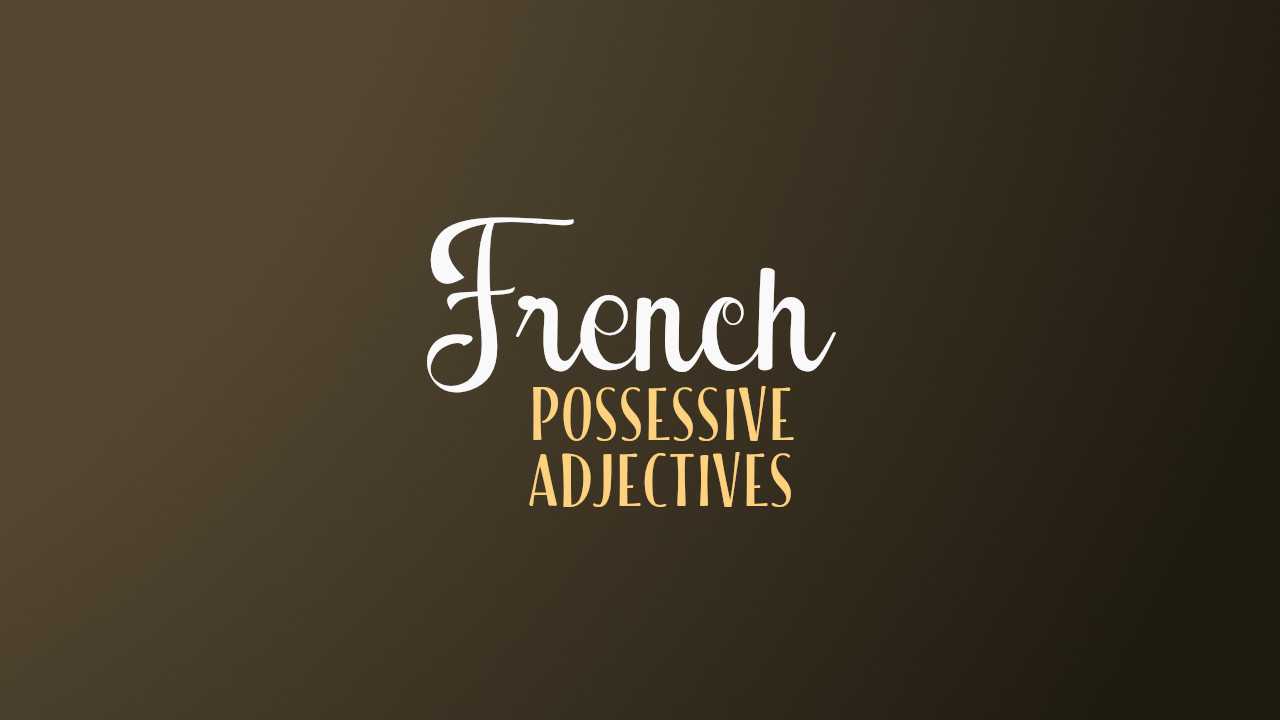Possessive adjectives are a crucial part of French.
You may have come across possessive adjectives in your French course or French apps. They’re key to chatting with friends and family about items and possessions.
There are a few rules for using possessive French adjectives, but they can be tricky to learn if you’re just getting started.
If you’re wondering how to use French possessive adjectives, read on 😊.
What are French possessive adjectives?
Possessive adjectives are French words that show who owns the noun in a sentence.
Each has different forms depending on the noun’s gender and number.
There are 18 possessive adjectives you’ll eventually need to know.
Table of French possessive adjectives
Want to know some of the main examples of possessive French adjectives 🤔?
Check the table below to find them:
| English possessive adjective | French masculine singular | French feminine singular | French plural form |
|---|---|---|---|
| My | Mon | Ma | Mes |
| Your | Ton | Ta | Tes |
| His/her | Son | Sa | Ses |
| Our | Notre | Notre | Nos |
| Your | Votre | Votre | Vos |
| Their | Leur | Leur | Leurs |
Singular vs plural
The difference between singular and plural possessive French adjectives is that they describe different numbers of nouns.
You’ll hear French native speakers using singular possessive adjectives when talking about one item that someone owns.
On the other hand, you’ll hear French native speakers using plural possessive adjectives when talking about two or more items someone owns.
For example, if you want to say that your dog is calm, you can use the singular, masculine possessive adjective mon:

Mon chien est calme.
If you want to say that your dogs are calm, you can use the plural adjective mes:

Mes chiens sont calmes.
Usage
You’ll need to consider three rules to use possessive adjectives when writing and speaking in French.
These rules refer to positioning and noun modification related to gender and number. Here’s more information about these rules.
Possessive adjective syntax
When considering how to use possessive adjectives in French, remember that your adjective should come before the noun or adjective it modifies 😀.
Here’s an example to help you see how this rule of positioning works:

Où est ta chaise ?
In this example, you’ll notice that the adjective ta appears before the noun chaise.
That’s the structure and positioning you should try to use.
But let’s look at another example that includes a French adjective:

Ton beau visage me rend heureux.
Here, the adjective ton appears before the French adjective beau.
There are no exceptions to this rule, so it’s well worth remembering this concept to speak and write correctly in French.
Gender
All French nouns have a gender, which their article can help you understand.
If you use a masculine French noun in a sentence, you should modify this with a masculine adjective.
However, if you use a feminine French noun in a sentence, you should modify this with a feminine adjective.
Here is an example of each noun modification to help you understand this rule:

Sa maison n’est pas très grande.

Son rasoir doit être rechargé.
In the first example, you’ll notice that the feminine adjective sa modifies the feminine French noun maison (la maison).
The second example shows that the masculine adjective son modifies the masculine French noun rasoir (le rasoir).
Remember that possessive adjectives don’t change according to the gender of the person who owns the noun.
💡One tip for using these adjectives is to learn the gender of all French nouns first with French resources by looking at the article (le, la, les, l’, un, une, des).
With this method, you will know the form of the adjective to use when modifying the noun.
Number
When you use a plural French noun, you’ve got to remember to use a plural adjective to modify it.
Here are two examples to clarify this.

Mes chiens sont tous calmes et silencieux.

Tes robes sont très jolies.
You can see that the adjectives mes and tes take the plural form because they modify plural French nouns chiens (les cheins) and robes (les robes).
Now, if you look at the table above, you will notice there’s only one column for plural French adjectives.
Plural French possessive adjectives don’t have different forms for masculine plural or feminine plural nouns.
This grammatical structure makes it easier to remember how to use plural adjectives when you use a plural French noun.
There’s no need to remember a separate set of plural adjectives for feminine nouns.
3 rules to remember
There are a few exceptions to consider when you’re using adjectives in French.
1. Use a masculine adjective if a feminine noun starts with a vowel
Although the adjectives should use the same gender as the noun it modifies or describes, if you have a feminine noun that starts with a vowel, you should use a masculine adjective.
2. Use a masculine adjective if a feminine noun starts with a silent h
Similarly, if you use a feminine noun that begins with a silent h, you’ve got to use a masculine adjective.
There’s a key reason for these rules: it makes it easier to pronounce your sentence and avoid two vowels clashing 😀.
Don’t say “ta auto”. Instead, say ton auto.
3. Don’t use possessive adjectives when describing body parts
You should also avoid using French possessive adjectives when you’re describing body parts.
Instead of saying “elle s’est cassé son doigt”, say elle s’est cassé le doigt.
Using possessive adjectives is unavoidable if you want to describe ownership.
I recommend reading this guide on French nouns as well which you may find helpful. 😀
🎓 Cite article
 Grab the link to this article
Grab the link to this article![Black Friday (2025) Huge Language Learning Deals [+ Gift Ideas]](/.netlify/images?url=_astro%2Flanguage-learning-gifts.B3xs8tp4.jpg&w=270&h=152&q=50)











































COMMENTS
NO ADVERTISING. Links will be automatically flagged for moderation.